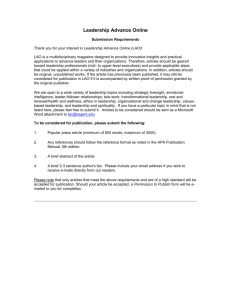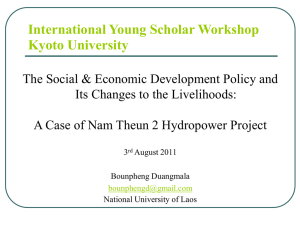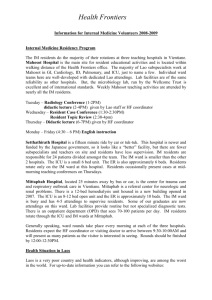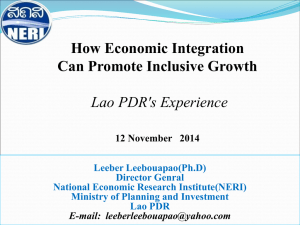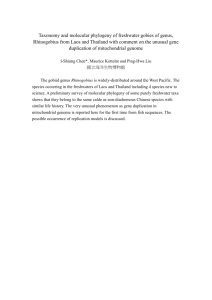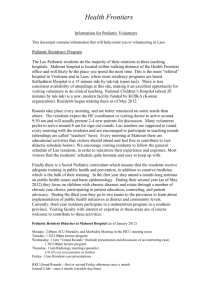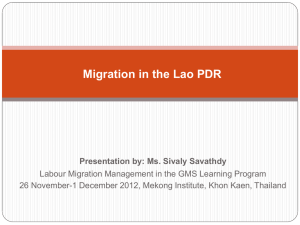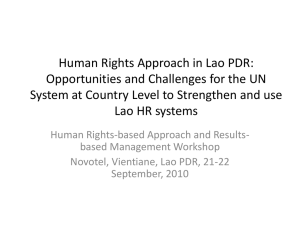gender and development in Laos
advertisement
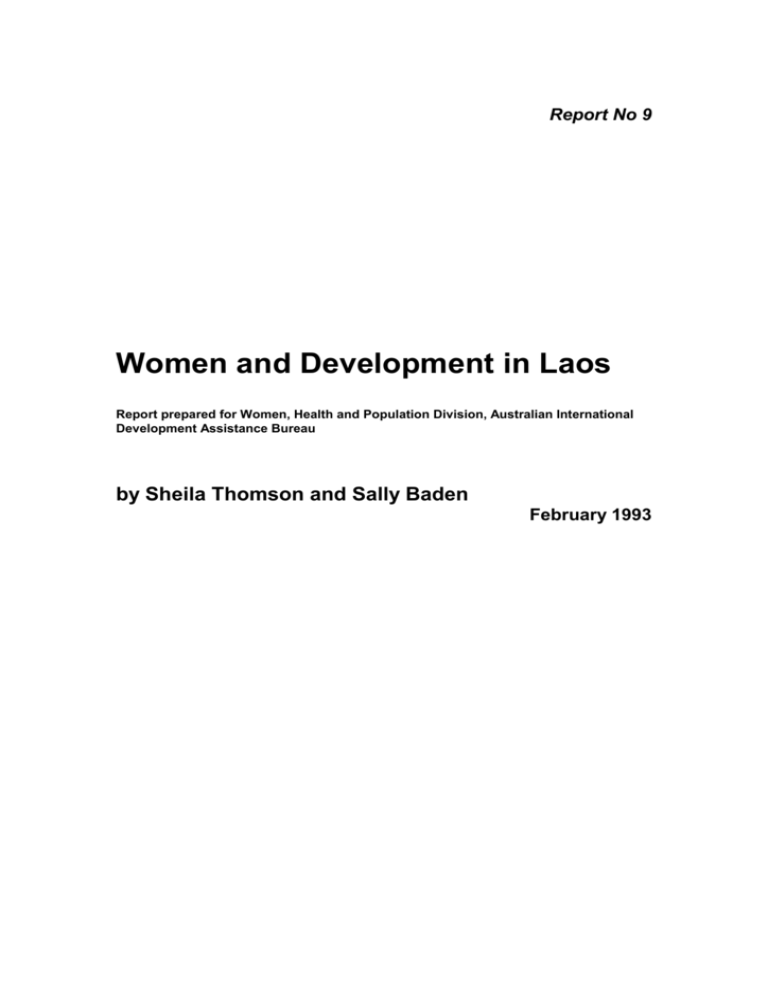
Report No 9 Women and Development in Laos Report prepared for Women, Health and Population Division, Australian International Development Assistance Bureau by Sheila Thomson and Sally Baden February 1993 CONTENTS 1. INTRODUCTION............................................................................................................1 2. RECENT HISTORICAL OVERVIEW (1975-1992) ......................................................2 3. OVERVIEW OF WOMEN’S ROLE IN THE NATIONAL AND HOUSEHOLD ECONOMIES ...............................................................................................4 4. WOMEN’S ROLE IN THE RURAL ECONOMY..........................................................5 4.1 Agriculture ..........................................................................................................5 4.2 Cottage industries ................................................................................................6 5. WOMEN’S PARTICIPATION IN THE URBAN ECONOMY .....................................8 5.1 Formal Sector ......................................................................................................8 5.2 Informal Sector ....................................................................................................9 6. INDICATORS OF WOMEN’S STATUS .......................................................................10 6.1 Education.............................................................................................................10 6.2 Health ..................................................................................................................11 6.3 Politics .................................................................................................................13 7. INSTITUTIONAL MECHANISMS FOR CHANGE......................................................14 7.1 Lao Women’s Union ...........................................................................................14 7.2 International assistance .......................................................................................15 8. CONCLUSIONS AND POLICY RECOMMENDATIONS ...........................................16 BIBLIOGRAPHY* ................................................................................................................18 FIGURES AND TABLES .....................................................................................................21 NOTE .....................................................................................................................................27 1. INTRODUCTION Lao women’s concerns were first formally addressed by a national government in 1975, with the ascendancy to power of the Lao People’s Revolutionary Party. The new communist regime had earlier promised to ‘realise equality between men and women in all fields, political, economic, cultural and social, and to do away with all acts of contempt or oppression toward women’ (Brown and Zasloff 1986: Appendix A). On taking power, the LPRP encouraged women to participate in activities of national reconstruction and the building of socialism. In spite of the Government’s formal commitment to eradicate gender inequality and its promotion of women’s economic participation, Lao women today have far from achieved parity with Lao men in the areas mentioned. Considerable advances have been made in women’s access to education and employment since 1975, but women’s social status and political representation remains low. (Ng, 1991: 174-5.) Furthermore, the dire economic situation faced by the country has imposed increasing demands on the time and energy of women. This report begins with a brief overview of the political, demographic and economic situation in Laos in the 1975-92 period. Following this is a short section on Lao women’s participation in economic development after 1975. Women have made a vital contribution to both the rural and urban economies, particularly the former. The discussion of the rural sector will concentrate on agriculture and small scale industries, and that of the urban sector will cover the formal and informal sectors. Despite women’s essential contribution to the development of Laos, gender disaggregated data on education, health and political representation show that women still lack access to basic services and political power. Nonetheless, women are organised at the local, provincial and national levels through the Lao Women’s Union (LWU), an organisation with a membership of more than one third of the female population. Even so, it has only been in the last few years that this organisation has focused its attention specifically on women’s concerns and not simply those of the revolutionary state. This organisation faces several challenges in its attempts to redress women’s subordination in Laos. Some of these constraints have been tackled recently with the assistance of the international community. The nature of this foreign assistance will be outlined, and followed by some policy recommendations. This report is limited in nature due to the lack of research on the socio-economic situation of Lao people, and particularly of Lao women. Most of the literature written on Laos to date has focused on the military and strategic aspects of the country. Furthermore, the little information which does exist on Lao women is almost exclusively concentrated on Lowland women who make up only one half of the female population. However, an attempt will be made to incorporate information on the situation of Highland women where possible. 1 2. RECENT HISTORICAL OVERVIEW (1975-1992) A brief overview of the recent political, demographic and economic situation in Laos is necessary to provide a context for the following discussion. Laos is presently governed by the Lao People’s Revolutionary Party (LPRP) which assumed power in 1975 after more than thirty years of armed struggle against the French colonialists and later against American forces in the Indo-china conflict. Women were active in all spheres of work during the wars, from militia activity, to health care of soldiers and food production (UNESCO, 1989: 5). The three decades of war, and the half century of French colonialism before it, has left Laos one of the poorest countries in the world. The economy remains predominantly agrarian with a gross national product per capita of a mere US $ 180 in 1989 (UNDP, 1992). Laos has a population of 4.2 million, and a sex ratio of 96.1 males per 100 females (Frisen, 1991: 58). Eighty-five percent of the people live in rural areas. The country has a total area of 236 800 square kilometres, but only 12 percent of the land area can be cultivated due to the mountainous terrain, impenetrable forests and to the massive destruction caused by US bombing in the 1960s and 1970s in which exfoliation agents were widely used (Heyzer 1986: 30). Ninety percent of the labour force is concentrated in the agriculture and forestry sectors with only two percent in industry and construction (Frisen, 1991: 63). Urban dwellers are concentrated in four major centres: Vientiane, Savannakhet, Pakse and Luang Prabang. The most densely populated city is the country’s capital, Vientiane, which has a population of 442 000 (Government of Laos PDR, 1992: 2). Laos has an extremely varied ethnic composition with over 68 distinct groups. These diverse peoples are often put into three categories. The largest group is the Lowland Lao, or Lao Loum, who make up 55 percent of the population and inhabit the plains and valleys. The Midland Lao, or Lao Theung, live on the plateaux and mountain slopes and constitute 27 percent of the population. The remainder of the population are Upland Lao, the Lao Soung of the mountain tops (Iinuma, 1992: 2). Because of poor infrastructure and communication systems, most of the Lao Theung and Lao Soung people still live in virtual isolation from the other more developed parts of the country. This study will perforce focus primarily on the situation of Lao Loum women. As far as economic development is concerned, Laos is currently undergoing a major economic transformation. In order to address the dire economic situation and to gain access to external financial assistance, the Lao Government enacted the New Economic Mechanism (NEM) in 1986. According to government sources, reforms introduced by the NEM include: - decontrol of prices and distribution of goods and services; - elimination of subsidies; - unification of the exchange rate; - reform of the tax system and government expenditure; - restructuring of the banking system and enactment of a new Central Bank Law; - refinements in money and credit management; - passage of a Law on Foreign Investment; - reduction of import duties; - revamping the tax and customs administration; - privatization of the means of production including some state enterprises; - formation of the policy apparatus for further privatization. (Government of the Laos PDR, 1992: 4) 2 These reforms contain many elements which are standard in structural adjustment programmes. The impact of such programmes elsewhere has been subject to a gender analysis which reveals a very mixed picture (see e.g. BRIDGE, 1992a). Adjustment programmes have several potentially negative outcomes for women. For example, price decontrol and subsidy removal creates pressure on household budgets, the burden of which is often borne largely by women; in other parts of Asia (e.g. Sri Lanka) trade liberalisation policies under adjustment programmes have led to the displacement of women working in handloom and other home based production (Jayaweera, 1992). No study has yet been made of the gender effects of these macroeconomic policy changes in the Lao case. Some consequences of the reform programme in Laos to date are a fall in real urban incomes resulting from price rises, and increased unemployment through public sector retrenchment. Women are thought to have been particularly hit by reductions in public sector employment because they generally occupy lower ranking positions. (Government of Laos P.D.R, 1992: 18-20.) In December 1991, the Medium Term Policy Framework and Public Investment Programme (1991-5), was approved. This does not incorporate any specific gender analysis or concerns. (Iinuma, 1992: 5.) However, there is a strong emphasis on human resource development, particularly through investment in health and education (Government of Lao P.D.R and UNICEF, 1991: 6). In parallel with the economic reform programme begun in 1986, there have been a number of legal reforms and a new constitution was enacted in August 1991. The constitution provides the legal basis for equality for women in the political, economic, social and cultural fields and in family affairs. Several of the new laws relate to gender concerns, for example, the Property Law, the Inheritance Law, the Labour Law, the Family Law and the Election Law. Along with men, women have inheritance and voting rights. There is insufficient information available to discuss the precise gender implications of these changes. In any event, due to the recent implementation of these legal reforms and also to the fact that much of the Lao population lives in isolation from major centres, its seems unlikely that these changes have yet had a major impact. (Iinuma, 1992: 4; Government of Laos PDR, 1992: 20.) 3 3. OVERVIEW OF WOMEN’S ROLE IN THE NATIONAL AND HOUSEHOLD ECONOMIES Lao women have played a central role in the country’s economic development over the past two decades. Women’s participation exceeds men’s in the economically active population. Women made up 52.8 percent of the active labour force (15-44 year olds) in 1985 (Government of Lao PDR and UNICEF, 1991: 5). The distribution of women in various sectors is shown in Figure 1. Women compose 60 percent of the labour force in the agricultural sector; 60 percent of the handicraft sector; 50 percent in commerce, public health and education sectors; 25 percent in the public sector and 20 percent in the industrial sector. (UNESCO 1989: 18.) Aside from this enumerated work, a gender division of labour exists in Laos which assigns women the major responsibility for childcare and housework. As household size averages seven people (Ireson, 1991: 25), these tasks require numerous hours of work each day in addition to women’s work outside the home and yet domestic labour continues to be excluded from labour force statistics. Lao Loum women are generally thought to enjoy a higher status than women of other ethnic groups (e.g. the Yao and the Hmong), among whom son preference is quite strong in accordance with kinship and inheritance structures. The Lao Loum have bilateral kinship systems and inheritance patterns, as well as a matrilocal tradition, whereby the married couple live with the wife’s parents at least for some years after marriage. In many cases, the youngest daughter and her husband remain with the parents to look after them in their old age. Thus, females often inherit property from their parents. By contrast, the Lao Theung and Lao Soung tend to adhere to patrilinear kinship rules and patrilocal traditions, whereby the woman is considered a member of the husband’s clan upon marriage. Where women are isolated from the support networks of their natal families, they are more likely to be dominated by the men in the household. (Government of Laos PDR and UNICEF, 1991: 2; Ireson, 1991: 24-5; Iinuma, 1992: 3.) All ethnic groups have traditionally observed bride price, although the Government has discouraged this. In some minority areas, polygamy is practised, but rural poverty is tending to limit this. In spite of their major economic contribution, women are generally not considered as workers. However, women, particularly older ones, do control household budgets and share in financial decision making. (Iinuma, 1992: 3; Ireson, 1991: 25.) 4 4. WOMEN’S ROLE IN THE RURAL ECONOMY 4.1 Agriculture1 Agriculture is the largest sector of the Lao economy accounting for 60 percent of GDP (1989) and employing 90 percent of the total population (Government of Laos PDR 1992: 5). General activities include rice cultivation, slash and burn cultivation, animal husbandry, vegetable growing and forest collection. Women compose 60 percent of the active labour force in the agricultural sector. The division of labour in the rural areas is such that all women, regardless of their ethnicity, are disproportionately overburdened with work. Table 1 gives an approximation of the gender division of labour in agriculture for the Lao Loum. The male household head generally organises and directs family paddy production (Ireson, 1989: 7-8). In family rice cultivation, women typically perform the following tasks: transplanting, weeding, sowing and almost all post-harvesting tasks including the gleaning and cleaning of the rice. Men prepare the land for cultivation with the help of buffalos, and thresh and harvest the rice along with women. In areas where slash and burn cultivation occurs, women traditionally weed while men cut down trees and burn the stumps in order to clear the land for cultivation. (Iinuma 1992: 5; Ireson, 1989: 8-9.) The division of labour described thus far, however, is not absolutely fixed as women often also perform tasks which are traditionally male, possibly because of the predominance of women in the rural provincial population due to the wars and to male out-migration (UNESCO 1989: 9). Men sometimes also perform traditionally female tasks such as transplanting or tending gardens (Ireson, 1991: 24). In some areas, cooperative groups carry out all the paddy rice work collectively, from seed-bed preparation to harvesting. Women and children still carry out the post harvest processing and prepartion (Ireson, 1989: 9). Women also cultivate vegetables and some cash crops, and collect roots, shoots, firewood, and small animals from nearby forests mainly for subsistence purposes. Men hunt, collect timber and build and repair houses. Both sexes fish and gather river produce. Women are usually responsible for marketing family produce, except when there are large quantities of surplus rice and when large animals are to be sold. (Government of Laos PDR 1991: 5; Ireson, 1991: 24.) A further activity of Lowland rural households is animal husbandry. Raising small stock (pigs, goats, chickens and ducks) is women’s responsibility while cattle, buffalo and horses are men’s domain. Children are also involved in feeding and grazing stock. Animals are one repository for family wealth, with the larger animals raised by males commanding the highest prices in the market. (Ireson 1989: 9.) Land, however, is often inherited by daughters among the Lao Loum (see above), but this is not the case among the other ethnic minorities.2 (Iinuma 1992: 3). 1 Agriculture is broadly defined in this report to include shifting cultivation and forestry. In 1978, the Lao Government adopted a collectivization programme for the country which met with considerable opposition from the rural population. The collective ownership programme also had a negative impact on agricultural output, and was largely abandoned in late 1979. The existing cooperatives were maintained and subsidised, and in the mid eighties about one fifth of the agricultural population worked in cooperatives. Since then their importance has diminished and is likely to continue doing so. Under new policies adopted in 1988, many cooperatives have now returned their land to the original owners to farm individually. Although land is formally national property, private farmers have individual cultivation rights which are hereditable and saleable. (Bourdet, 1991: 7; Ireson, 1989: 9.) 2 5 Aside from the responsibilities mentioned above, women of all ethnic groups perform the tedious and time-consuming chores associated with household management and child care. Some of these duties include water collection, which may take two to three hours a day; husking rice for family consumption, which may require two hours of work; milling rice; and caring for the sick and the elderly. (Ireson 19 :11.) Girls assist their mothers with these chores and they are often made responsible for care of younger siblings. It is clear that women farmers have made a vital contribution to both household and national economies. However, women face a number of constraints which deny them access to the means required to increase their labour productivity. Aside from the burden of housework, Lao women lack skills training in agriculture as there are no government extension services in the country. Even when this service did exist prior to 1975, women were denied access to agricultural training. Instead, they were taught sewing and cookery. This reflects traditional stereotypes which view only males as farmers. In Laos, however, female farmers actually outnumber the males. (Ireson, 1989: 9.) A further constraint faced by women farmers is a lack of access to the credit needed to expand production. Government agricultural credit schemes carry extremely high interest rates. Moreover, although some machinery has recently been introduced into farming activities, it is predominantly men’s tasks which have been mechanised. The most common machines include tractors to facilitate the ploughing and harrowing of land and rice threshers. (Ireson 1989: 9.) Women’s access to credit facilities, agricultural training and appropriate technology have nonetheless increased since the imposition of the NEM in 1986 as several external agencies have initiated projects targeted specifically at addressing women’s productive needs (see section 7.2 of this report). Finally, women face increasing time and resource constraints resulting from the escalating deforestation which has occurred in Laos. The primary causes of this environmental degradation are logging and the clearing of land for shifting cultivation. It is estimated that 70 000 hectares of dense forest and 200 000 hectares of less dense forest are depleted each year. This loss of forest has serious consequences for women as it forces them to travel greater distances to collect wood and other essential forest products. Deforestation has particularly adverse effects on women in the Highland areas where household survival depends almost solely upon forest food and medicinal plants (Ireson 1991: 23). The Lao Government has begun to address the problem of deforestation by imposing bans on the export of logs and timber, first in January 1989 and again in August 1991. However, much more concerted efforts will be needed to enforce these policies as illegal logging is prevalent in Laos as it is all over South East Asia. (Iinuma, 1992: 6.) 4.2 Cottage industries In most cases, agricultural activities barely meet the subsistence demands of rural families. Employment opportunities are scarce in the rural areas and thus, in order to supplement family income, women engage in the production of handicrafts in their spare time and during slack agricultural periods. These small-scale activities include the production of cloth, clothing and blankets for both domestic use and sale. (Ireson 1991: 23.) The domestic demand for woven products was high before 1987 as the Lao Government had imposed strict controls on most imports including clothing. Women were encouraged by the Government to dress in the traditional cotton or silk made sin (sarong) instead of Western attire, for ideological as well as economic reasons. (Evans, 1990: 84.) Since trade restrictions have been relaxed with the introduction of the NEM, cheap manufactured clothing imports from Thailand have 6 been increasingly available in Lao markets. The implications of this for the demand for domestically woven garments, produced mainly by women, are as yet unclear, but it seems likely that a shift in demand away from domestically produced garments could occur, without special measures to protect or promote such cottage industries. Nevertheless, home-based weaving will continue to be an important economic activity for women particularly in isolated rural areas. Women are also largely in charge of selling their products in local markets. Although the supply of a product may exceed the demand in rural areas at any given time, poor transportation systems make it virtually impossible for marketing to occur over great distances. (Heyzer 1986: 33.) 7 5. WOMEN’S PARTICIPATION IN THE URBAN ECONOMY 5.1 Formal Sector Laos is a predominantly rural subsistence country and urban areas are still underdeveloped. Where women have found employment in the formal sector, their jobs are often gender typed and concentrated at lower levels. In factory employment, men outnumber women in all areas except for garment production. In the civil service, women are well represented in the education and health departments but seldom occupy directorial or managerial positions even in these ministries. Similarly, in the industrial sector, women are factory workers but rarely, if ever, managers. One exception to the normal gender typing pattern is the significant involvement of women in road construction and maintenance. (Ng, 1991: 175; Iinuma, 1992: 7,10.) The recent change of economic policies by the Lao Government will probably result in increased employment opportunities for women in the cities, but it is likely that they will continue to occupy the lowest rungs of the employment ladder. Laos’ comparative advantage in the world economic market is undoubtedly its cheap labour and in Laos as elsewhere, women’s labour is likely to be available at lower cost than men’s.3 Furthermore, given Laos’ budgetary constraints, it is likely that the country will try to develop small scale export industries including textiles and electronics, drawing on foreign investment. These industries typically favour the employment of young women. Employment opportunities have opened up for women in such industries all over Southeast Asia, due in part to the activities of multinational corporations in the region and their specific demand for female labour. Whilst such new opportunities may increase the quantity of female employment in the industrial sector, doubts have been raised in the context of other Asian countries about the quality of this type of female employment, particularly with regard to job security, working conditions and skills development (Jayaweera, 1992). Women’s participation in the commerce and the service sectors may grow at a higher rate than men’s with the expansion of tourism and trade. This has been the case for Laos’ neighbour Thailand where women have come to predominate in the commerce and service sectors (Thomson, 1991). There are plans to encourage women’s employment in tourism especially as guides. (Iinuma, 1992: 7). 3 There is little data on the pervasiveness of gender differentials in pay in Laos. Iinuma states that in road construction and maintenance work, women and men are paid the same (Iinuma, 1992: 10). In agricultural co-operatives, however, there are instances of men and women receiving different workpoint remuneration for performing the same tasks (UNESCO, 1989: 30). More systematic research is needed to reveal the patterns of gender differentials in pay and remuneration. 8 5.2 Informal Sector Women are active participants in the thriving informal sector markets in the urban areas. Trading in these areas is lucrative as state stores are unable to fulfil the demand for goods of the urban dwellers. Informal sector activities in which women predominate include: the sale of food along roadsides; providing domestic services for foreigners; small-scale retailing; and handicraft production. (Ng 1991: 179.) Many women are said to have left jobs in the public sector in order to engage in informal sector activities. Although employment in the civil service is more prestigious, salaries are much lower than the incomes women can earn from trading. Men, however, prefer to remain in the higher status government service jobs. In doing so, they retain access to other benefits including subsidised goods and rice rations.4 (Heyzer 1986: 34.) Women should be able to take advantage of new trading opportunities resulting from economic liberalisation as they already have established marketing networks and a sense for market trends. Increased income for women from informal sector activities may improve their bargaining position in the household and provide them with increased independence from men. However, other factors could counteract this, for example if the number of informal sector workers increases rapidly as a result of formal sector unemployment, there may be downward pressure on informal sector incomes. 4 The implication here is that where husband and wife both work in the public sector, the household derives maximum benefit if the woman leaves her job to exploit more lucrative trading opportunities whilst the man remains in the high prestige post and retains access to subsidised goods and other fringe benefits. It is not known to what extent these benefits have been affected under the economic reform programme. 9 6. INDICATORS OF WOMEN’S STATUS 6.1 Education Overall primary and secondary school enrolment ratios in Laos improved between 1975-6 and 1983-4 (from 67.5 percent to 85.4 percent for primary level and from 10.8 percent to 26.5 percent at lower secondary level) and the primary enrolment ratio is now average by Asian standards. Data are imcomplete but show that the trend to improvement slowed and may even have been reversed between the early and mid1980s. Secondary school enrolment was still extremely low at 13.9 percent in 1983-4, indicating the low education level of children in absolute terms. (UNESCO 1989: 12.) A UNESCO study conducted in 1985 showed that out of 1,000 children who had enrolled in first grade, only 139 students completed fifth grade. This was due to the poor quality of education and to domestic responsibilities imposed on children. (UNESCO, 1989: 14.) The educational status of women in Laos has advanced considerably since 1975. The percentage of female students in Lao schools increased from 37.6 percent in 1975-6 to 45.3 percent in 1980-1. By 1984-5 the percentage of female students was 46.7. (UNESCO, 1989: 17.) However, the general educational level of Lao women is still very poor, and the gender gap, though narrowed, persists, particularly beyond primary level. Female school enrolment is consistently lower than male enrolment at all levels of education. The percentage of female enrolment in 1985-6 at the primary, lower secondary and upper secondary levels was 44.9 percent, 42.8 percent and 40.1 percent respectively (UNESCO 1989: 18). Furthermore, regional variations in overall primary school enrolment are great ranging from 10 percent in some areas to 94 percent in others (UNESCO, 1989: 13). Table 2 demonstrates the urban bias in education. Whereas the female primary school gross enrolment ration is 48 percent for Lao Loum groups, it is only 26 percent for Lao Soung groups. (Government of Laos P.D.R and UNICEF, 1991: 3). Highland women are the most poorly educated people in the country. Laos has four universities as well as professional schools. In 1985-6, women accounted for 28.05 percent of total enrolment at the higher education level (UNESCO, 1989: 18). Female students were relatively well represented in health sciences (53.1 percent in 1985-6) and teacher training (37.7 percent in 1984-5) but constituted less than 20 percent of the total enrolment in architecture, and at the polytechnical college. (UNESCO, 1989: 25.) Literacy rates are further indicative of Lao women’s educational disadvantage. A UNESCO study, carried out in 15 of the 17 provinces in 1984-85, determined that 56 percent of the population was illiterate, despite government assertions that illiteracy had been eradicated by 1984 (Ng 1991 :161). The study showed that illiteracy was acute among Laos’ ethnic minorities; that it was higher in rural areas than in urban areas; and also higher for women than for men. (UNESCO 1989: 10.) These claims were further confirmed by a Food and Agricultural Organisation study on literacy in Laos which recorded a specific sex inequality in literacy rates for three provinces: Vientiane, Luang Prabang and Champasak. This distribution is shown in Figure 2. The overall literacy rate for Lao women is estimated at 35 percent, compared to 65 percent for men (Government of Laos PDR 1992: 2). The low education level among females results from two basic factors: inadequate overall educational provision in the country, and continued gender discrimination faced by girls and women. The education system is Laos is highly inadequate for two major reasons. Firstly, it lacks the proper funding required for minimal infrastructural 10 requirements, such as school buildings and teaching equipment, as well as for recurrent costs, particularly salaries. The Government has realised the need for increased financial support for the education system and this is reflected in the share of its budgetary expenditure on education which has increased from 3.7 percent for 1981-1985 to 8 percent for 1986-1990. However, development analysts have reported that this allotment is still too low. (Ng 1991: 167.) Secondly, the lack of qualified teachers in Laos contributes to the poor quality of education. Laos was reported to have lost 90 percent of its educated population in 1975 due to the massive outflow of refugees after the Communist takeover. (Ng 1991: 182.) Systemic barriers to women’s equal participation in education are numerous. Traditionally, women did not attend school as education was provided by monks in the pagodas and girls were prohibited from attending these lessons. This bias in attitudes still persists today. Boys consistently receive priority over girls with respect to education. (UNESCO, 1989: 10.) Although girls and boys enrolment rate in primary and secondary education is moving close to equality (see above), sources suggest that the drop-out rate for girls is higher than it is for boys (UNESCO, 1989: 25). This may be due to greater domestic and other labour responsibilities of girls. A 1982 ILO study of Hat Xai Fong district in Vientiane Province showed that 8.6 percent of girls in the 6-15 age group, compared to 3.3 percent of boys, were engaged in crop production, livestock rearing and related activities (Mukherjee and Jose, 1982: 20). Women’s household responsibilities greatly limit their ability to attend adult nonformal education classes. Even if government campaigns to eradicate literacy had been sustainable and systematic, which they were not, women would have still not benefited fully from them. This is due to the male biased assumption often inherent in literacy campaigns that all members of society have equal amounts of time to devote to education. 6.2 Health General health conditions in Laos, and women’s health standards in particular, reflect trends similar to those in education levels. Table 3 shows some basic indicators of overall health conditions for women and children in Laos for the decade 1980-1990. Life expectancy at birth was slightly higher for women, at 50 years compared to 47 years for men. In 1970, women’s life expectancy had been only 41.8 years, demonstrating a gradual, real improvement in health conditions for women (WHO, 1989). However, the maternal mortality rate in 1988 was still one of the highest in the world at 750 deaths per 100 000 live births. This ratio is as low as 150: 100 000 in Vientiane and as high as 900: 100 000 in the rural provinces. (Government of Laos PDR and UNICEF, 1991.) Laos’ infant mortality rate is also very high at 104 deaths per 1 000 live births in 1990. Again, in Vientiane the ratio approximates 50 : 1 000 while in some mountain districts it is as high as 299: 1 000. (WHO, 1989: 4.) Very many children do not survive until their fifth year. The under-five mortality rate in 1990 was 152 deaths per 1000 live births. Regional variations in infant and child mortality rates are marked. In some upland provinces as many as one third of babies die before their first birthday. (UNESCO, 1989: 22.) A further indication of the difference in the quality of health care between the urban and the rural areas is number of population served by a doctor in different areas. In Vientiane this ratio is 1: 1 400 whereas in other parts of Laos the ratio is as high as 1: 12 600. (Foley and Vongsak, 1991: 69.) Most maternal deaths could be easily prevented as they result from treatable causes, for example, lack of immunization against diseases such as tetanus and tuberculosis; 11 diarrhoea; lack of spacing between pregnancies; and malnutrition5 (UNESCO, 1989: 22). Malaria is less easily preventable, and is the prime killer of Lao children. Other main causes of death among children include gastrointestinal and respiratory diseases, and malnutrition. (UNESCO, 1989: 21.) Poor health conditions of women are further exacerbated by public health constraints such as shortfalls in access to health services, safe water and sanitation. The proportion of people with access to these services are 67, 29 and 12 percent respectively (UNDP, 1992). Approximately ninety percent of all births take place at home with untrained attendants (Government of Lao P.D.R and UNICEF, 1991: 4). Past government efforts in collaboration with the World Health Organisation (WHO) and UNICEF to expand immunization programmes have failed to make a significant impact on the eradication of childhood diseases. Some obstacles encountered by this programme included poor management and implementation by ministry officials; infrastructural constraints such as poor transport and communication systems; and financial limitations (Ng, 1991: 171). Until recently, the Government has invested little in improving health care in Laos. Public expenditure in this sector increased only slightly from 0.5 percent of GDP in 1960 to 0.6 percent in 1987, rising to 2.0 percent in 1992. (Iinuma, 1992: 8.) In spite of this significant increase in health expenditure in the last five years, which is now above the (1.4 percent) average for developing countries, the level of expenditure is still too low for the provision of adequate health care systems. The Lao Government has had a strongly pro-natalist population policy due to what it sees as the need to increase the small population size in order to encourage increased economic growth. The sale of contraceptives was banned in Laos until 1988. (Iinuma, 1991: 2.) Pro-natalist policies have had a negative impact on women’s health as contraceptives are required to prolong birth intervals. In 1990, the total fertility rate was 5.7 births per woman, a figure which although decreased from 6.2 births in 1970 (UNDP, 1992), is still too high. Inadequate birth spacing continues to claim hundreds of mother’s lives. In recent years the government’s position on birth control has improved slightly with the recognition that the high birth rate was having detrimental effects on population growth as mortality rates remained high. Seven programmes to promote child spacing were introduced in 1991 (Frisen, 1991: 62). The low awareness and use of contraception in Laos has a second serious corollary: the likely rapid spread of HIV/AIDS. Although there have only been a few HIV/AIDS cases reported to date in Laos, the incidence of HIV/AIDS is likely to increase in light of increased trade and other contacts with Thailand, which has one of the most serious HIV/AIDS problems in Asia. (Iinuma 1992: 8.) A study on family planning conducted by UNESCAP showed that 65 percent of the women interviewed had no knowledge of any form of contraception. Of the less than 20 percent of women who used contraceptives, the pill was the most common form at 45 percent while condoms were the least used at less than one percent (Foley and Vongsak, 1991: 75.) It can be safely concluded that at present a minute number of people use condoms in Laos in which case the risk of the rapid spread of HIV is acute. Other factors may also contribute to the increased risk of a rapid spread of HIV, such as the promotion of sex tourism which is now said to be being diverted from Thailand to Cambodia and Laos (BRIDGE, 1992b). In 1991, a Mid Term Plan of Action for Control of AIDS was set up, apparently with a strong emphasis on women’s role in AIDS control (Iinuma, 1992: 8). 5 Some sources suggest that malnutrition in Laos is often the result of a lack of education about nutrition. For example the traditional post partum food for most women consists of salted boiled rice which may be women’s exclusive diet for up to three weeks after child birth. (WHO, 1989: 8.) 12 6.3 Politics A third indicator of women’s status in Laos is their representation at different levels of political organisations and institutions. Laos has a dual political structure which consists of the Communist Party and the Government. The Communist Party is a hierarchical organisation controlled by a seven member all-male Politburo, the key policy making body of the country. The next most powerful decision making group in the party is the Central Committee of which five out of 59 members are female. The final tier in the party is the ordinary membership of 60 000 and women make up 40 percent of this group. (Iinuma, 1992: 4.) Women’s representation in the Government follows much the same pattern. The distribution of women in the civil service is shown in Table 4. The only female minister is the president of the LWU. Overall, women are fairly well represented in the civil service; but they are under-represented at director level in ministerial departments, although quite a few do become vice-directors. (Ng, 1991: 175.) Those who do occupy such posts are found in traditionally female sectors such as health and education. Below the ministries are the provincial, district, sub-district and village offices. Sources suggest that even at these levels, women are barely represented, except as Women’s Union representatives on district, sub-district and village administrative committees. Village heads appear to be almost exclusively male and external agencies have experienced difficulties in drawing women into discussions due to the dominance of men in public roles at village level. (Ireson, 1989; Iinuma, 1992: 3.) By law women are eligible to stand for public and administrative posts at all levels of Government but this right is not exercised for several reasons. (UNESCO 1991: 29) Although the Government is nominally committed to gender equality, many political leaders continue to believe that women are only suitable for employment in certain ‘nurturing’ sectors such as health care and education. This bias was clearly demonstrated by the General Secretary of the Party’s Central Committee when he stated in 1982 that: In the new revolutionary stage, work among women is aimed at achieving equality between men and women ... We should assist our women ... [to] participate in the management of the affairs of the country, especially in jobs suitable to women such as those in health services, education and so on. (Ireson 1989: 12.) A further reason for women’s lack of presence in the broader political hierarchy is that those women who are active in formal politics tend to operate within the Lao Women’s Union. One of the largest barriers to women’s participation in political activity, however, is time. The major prerequisites for nomination to party membership and to leadership positions are active participation in state organised activities; and punctuality, good attendance and willingness to perform overtime duties in the workplace. Women, who are over-burdened with domestic concerns, are often prevented from meeting these qualifications. Those women who have attained high positions in politics are in most cases related to powerful men in the country and have the resources to hire other women to perform their domestic duties. (Ng 1991: 175-6.) Finally, there is a strong socio-cultural bias against women’s active or vocal participation in public life, which seems to persist, particularly at the village level (Ng, 1991: 177-8). 13 7. INSTITUTIONAL MECHANISMS FOR CHANGE 7.1 Lao Women’s Union The Lao Women’s Union (LWU) is a mass-based organisation with a membership of 500 132 women, almost half of the female population of Laos aged 15-60 years (Government of Laos P.D.R and UNICEF, 1991). The organisation extends from the national level where it has the status of Ministry, through to the village level. The LWU has links with every ministry, state organisation and government sector (UNICEF 1987: 72.) Given the size and level of organisation of the LWU, it appears to be the only viable institutional channel through which to mobilise women, or implement projects or programmes specifically aimed at women. The LWU was established by the LPRP in 1955 under the name of the Lao Patriotic Women’s Association. For many years the primary task of the organisation was to mobilize women in support of the revolutionary struggle. From 1975 onwards, the Patriotic Women’s Association mobilised women in the tasks of national reconstruction and building socialism. Defending women’s specific interests was only a secondary concern. In fact, the organisation’s slogan of the ‘three goods and two responsibilities’ contradicted their goals for women’s emancipation. Women were encouraged to be good citizens, good mothers and good wives. Furthermore, they were expected to seek employment outside the home and to actively participate in national construction and defence. (Ng 1991: 176.) Nowhere in the LWU programme was there any mention that men should equally share in household tasks. In 1984, the LWU held its first national congress and changed its name. A second congress was held in 1989 where the tasks and roles of the LWU were more clearly defined. A small group of more educated women assumed leadership positions at this time, and the organisation has more recently been shifting its emphasis to directly addressing the needs of women, particularly poor rural women. (Government of Laos P.D.R and UNICEF, 1991: 6.) The Union is presently involved in several activities to promote women’s interests. These include collaboration with the Ministry of Education in campaigns to combat female illiteracy especially among adult women and women of ethnic minorities; training for women in general health care, hygiene, child/natal care and nutrition; and introduction of time saving technologies for women and providing skills training for income generation. (Iinuma 1992: 10.) The LWU, however, faces several constraints which include lack of adequate funding and lack of trained personnel to implement projects. These needs are now increasingly being addressed by international donor agencies and some of these efforts will be discussed in the following section. 14 7.2 International assistance Following the adoption of the NEM, several non-governmental agencies, UN organisations and some bilateral donors initiated women’s projects in Laos. Funds and technical assistance are being directed towards programmes related to agriculture, health care and sanitation, income generation, child care and institution building. UNICEF and the Lao Government have set up a Women’s Development Programme (1992-6) working through the LWU, with an emphasis on women and child survival, health and development. Interventions are planned in the health, education and water and sanitation sectors. The institutional and information base for women and development activities will also be addressed by: enhancing the capacity of the LWU; improved gender disaggregated data collection; gender sensitization of policy makers; and women focused community development projects. (Government of Laos P.D.R and UNICEF, 1991: 6-10.) A list of other agencies currently supporting women’s projects in Laos and the activities they are supporting is presented in Table 5. 15 8. CONCLUSIONS AND POLICY RECOMMENDATIONS In spite of the long-standing political priority given to gender equality by the LPRP and the central role of women in the national and household economy, women in Laos continue to be marginalised by male dominated social and political institutions and restricted in their educational and employment opportunities. They also continue to have the major responsibility for domestic labour, at the same time as engaging in numerous activities to maintain household living standards often under conditions of extreme hardship. Women of the highland ethnic minorities are particularly disadvantaged due to the isolation and underdevelopment of these areas and to more male dominated socio-cultural institutions and attitudes. Furthermore, whilst some women may be in a position to benefit from the current thrust towards economic liberalisation, it is important to be aware that many maybe negatively affected by the wide ranging economic reforms. Interventions are required at various levels to ensure that women’s interests are kept at the forefront of the current processes of economic and political change in Laos. Some tentative suggestions are: Macro policy and institutional interventions 1. To promote more systematic consideration of gender concerns at the macro policy level, for example, in decisions on the allocation of government expenditure (interand intra-sectorally); in changes in trade policy, given the possible impact of this on women’s productive activities; in the promotion and regulation of export oriented industries where women are likely to constitute the major part of the labour force. 2. To provide financial aid and institution building assistance to the LWU, in particular to enhance its adminstrative and managerial capacity and its ability to lobby and liaise with technical ministries; 3. To assist in developing a reliable data base for women in Laos especially for assessing the situation and needs of Midland and Highland women. 4. To encourage more participatory assessment of women’s needs at local levels and provide women with the training and resources to organise their own development activities and to intervene in local decision making and resource allocating institutions more effectively. 5. To prioritise investment in health and education in order to extend and improve the quality of provision, particularly in underserved minority areas. 16 Health 6. To fund and support the development of appropriate health care programmes which integrate nutrition, sanitation, education and preventative measures such as immunization. This should be prioritised over institution based health care which would be inaccessible to the majority of the population. The improvement of women’s and children’s health status, particularly ethnic minorities, should be a major priority within this. 7. To promote an integrated approach to reproductive health, incorporating family planning, maternal and child health and HIV/AIDS prevention activities. Experience elsewhere has shown that men also need to be drawn into family planning and AIDS awareness activities for them to be effective. Education 8. To provide incentives to encourage female attendance and reduce drop out rates of girls. Scholarships, school feeding programmes, more local provison of schools and flexible timing are possible ways to encourage increased female enrollment and reduce drop out rates. This should be in the context of an overall drive to improve the coverage and quality of educational provision. 9. Renewed efforts are needed to combat female illiteracy, possibly in the context of other local development efforts (e.g. in health or agriculture). These need to be sensitive to the multiple demands on women’s time. Agriculture 10. Women should be recognised as farmers and provided with credit and training in new production techniques so that they can reduce their work burden and increase their labour productivity. Programmes should be sensitive to women’s time constraints which are in part determined by seasonality in agricultural requirements and by regional differences. Small scale industry 11. Women’s home based handicrafts production needs to be supported and promoted (possibly for export), particularly in view of increased competition from imported manufactured goods. Marketing 12. Women are already heavily engaged in small scale marketing operations in both rural and urban areas. This activity should be supported by the provision of credit facilities, combined with training in business and information skills, and the formation of women’s marketing organisations. 17 BIBLIOGRAPHY* BRIDGE, 1992a, ‘Social, economic and health implications of adjustment for women in developing countries,’ extended memorandum for DANIDA, Institute of Development Studies, Brighton ----------, 1992b, Women, HIV/AIDS and development: towards gender appropriate strategies in South East Asia and the South Pacific,’ report prepared for Women, Health and Population Division, Australian International Development Assistance Bureau, Institute of Development Studies, Brighton Bourdet, Y., 1991, Laos: reforming Laos’ economic system, Macroeconomic Studies 22/91, Institute of Economic Research, University of Lund, Sweden Brown, MacAlister and Zasloff, Joseph J., 1986, Apprentice Revolutionaries: The Communist Movement in Laos 1930-1985, Stanford, Hoover Institution Press. Evans, Grant, 1990, Lao Peasants Under Socialism, Yale University Press, London *Foley, P. J. and Vongsak, D., 1991, ‘Demographic health survey: Xay Thani District of Vientiane Prefecture, Lao People’s Democratic Republic,’ in Asia-Pacific Population Journal, Vol. 6, No. 4, UNESCAP, Bangkok *Frisen, C. M., 1991, ‘Population characteristics in the Lao People’s Democratic Republic,’ in Asia-Pacific Population Journal, Vol. 6, No. 2, UNESCAP, Bangkok *Government of the Lao P.D.R., 1992, The Lao People’s Democratic Republic: Volume I: Socio-Economic Development Strategies, Government of the Lao P.D.R., Vientiane *Government of the Lao P.D.R. and UNICEF, 1991, Draft Plan of Operations for Women’s Development 1992-1996, Government of the Lao P.D.R. and UNICEF, Vientiane Hakangard, Agneta, 1990, ‘Women in shifting cultivation: Luang Prabang province, Lao P.D.R,’ Development Studies Unit Report No 18, Department of Social Anthropology, Stockholm University, Stockholm *Heyzer, Noeleen, 1986, Working Women in Southeast Asia: Development, Subordination, and Emancipation, Open University Press, Milton Keynes * The references marked with an asterisk were extensively drawn on in the text. 18 *Iinuma, Takeko, 1992, ‘Country gender analysis for the Lao People’s Democratic Republic,’ report prepared for the Development Cooperation Office of the Swedish International Development Agency, Stockholm *Ireson, Carol J., 1989, ‘The role of women in forestry in the Lao People’s Democratic Republic,’ Mimeo, Silvinova Forestry Consultants *----------, 1991, ‘Women’s forest work in Laos,’ in Society and Natural Resources, Vol. 4 ----------, 1992, ‘Changes in field, forest and family: rural women’s work and status in post-revolutionary Laos’ in Bulletin of Concerned Asian Scholars, Vol. 24, No. 4, Oct-Dec Japan International Cooperation Agency, 1990, ‘The observation report on infectious diseases in Lao P.D.R,’ MCR/JR/90-22 Jayaweera, S., 1992, ‘Women and structural adjustment in Asia: a review of evidence,’ paper prepared for the Commonwealth Secretariat Asian Regional Seminar on Women, Adjustment and Economic Change in Asia, Kuala Lumpur, Malaysia, 5-8 January 1993 Mukherjee, C., and Jose, A. V., 1982, Report of A Survey of Rural Households in the Hat Xai Fong District in Vientiane Province of the Lao People’s Democratic Republic, Asia Employment Programme (ILO-ARTEP), Bangkok *Ng, Shui Meng, 1991, ‘Social development in the Lao P.D.R: problems and prospects,’ in Zasloff and Unger (eds.), Laos: Beyond the Revolution, Macmillan, London Thomson, Suteera, 1990, ‘Gender issues in Thailand development,’ paper prepared for UNDP, Gender and Development Research Institute, Bangkok United Nations, 1991, The World’s Women 1970-1990: Trends and Statistics, United Nations Statistical Office, New York UNDP, 1992, Human Development Report, UNDP *UNESCO, 1989, ‘Status of Women: Laos,’ Social and Human Sciences in Asia and the Pacific, RUSHAP Series on Monographs and Occasional Papers No 29, UNESCO Principal Regional Office for Asia and the Pacific, Bangkok *UNICEF, 1987a, An Analysis of the Situation of Children and Women in the Lao People’s Democratic Republic, UNICEF, Vientiane 19 ----------, 1987b, ‘Country programme recommendations: Lao P.D.R.,’ UNICEF, New York *WHO, 1989, Country Review: Laos P.D.R, WPR/WR 60/5 Zasloff, Joseph J. and Leonard Unger (eds.), 1991, Laos: Beyond the Revolution, Macmillan, London 20 FIGURES AND TABLES Table 1: Gender Division of Labour for Lao Loum Task Women Men Clearing of land X Sowing X Transplanting rice X Weeding X Harvesting rice X X Threshing rice X X Gleaning/cleaning rice X Vegetable growing X Cultivation of secondary crops X Forest product collection X Hunting X Fishing X Raising chickens/pigs X X Raising buffalo/horses/cattle X Child care X Weaving X Food preparation X House cleaning X Sources: Iinuma 1992; UNESCO 1989; Govt. of Laos PDR 1991; Ireson 1989, 1991. 21 Table 2: Regional Variation in Primary School Enrolment Ratios (per cent) Province Vientiane Municipality Enrolment 94 Phongsaly 42 Luang Namtha 30 Oudomsay 60 Bokeo 60 Luang Prabang 55 Houa Phanh 65 Sayaboury 76 Xieng Khouang 67 Vientiane 92 Bolikhamxay 67 Khammouane 68 Savannakhet 70 Saravane 65 Sekong 10 Champassak 80 Attapeu 46 Source: UNESCO 1989 22 Table 3: Basic Indicators of Women and Children’s Health Year(s) Whole Vientiane Rural Country provinces -----------------------------------------------------------------------------------------------------------Life Expectancy (years) 1980-1990 Maternal Morality Rate 900 (deaths/100,000 live births) Infant Mortality Rate (deaths/1,000 live births) 50 1988 ... 750 ... 150 1990 104 50 299 Under Five Mortality Rate (deaths/1,000 live births) 1990 152 ... 300 People per doctor (ratio) 1989 ... 1,400:1 12,600:1 Fertility Rate 1990 5.7 ... ... (births per woman) -----------------------------------------------------------------------------------------------------------Sources: Government of Laos PRD 1991; UN 1991; WHO 1989; UNESCO 1989; UNESCAP 1991 b 23 Table 4: Percentage of Women Functionaries in Various Ministries by Level (1982) Ministry of Agriculture Ministry of Health Ministry of Education Ministry of Industry Ministry of Public Works trans and comm Level T F % T F % T F % T F % T F % --------------------------------------------------------------------------------------------------------------------------------------------------------------------------Director/ Managerial 36 3 8.0 13 1 7.7 n/a n/a n/a 41 4 9.8 n/a n/a n/a Upper 299 5 1.7 244 73 29.9 1036 242 23.4 153 9 5.9 75 2 2.7 Middle 806 171 21.2 962 380 39.5 3168 1247 39.4 240 21 8.8 530 27 5.1 Lower 2460 335 13.6 9340 4942 52.9 16130 5254 32.6 637 254 39.9 1111 172 15.5 --------------------------------------------------------------------------------------------------------------------------------------------------------------------------Source: Lao Women’s Union 24 Table 5: External Assistance for Women’s Projects Agency Project/Activity Project Site AIDAB Financial support to SCF Australia Sayaboury and Borikhamsay CIDSE Weaving Borikhamsay, Savannakhet, and Sayaboury Borikhamsay and Savannakhet Poultry, vegetable growing, mother and child health, and rice mills Family Planning Service of birth spacing International and mother and child health Assistance care. Training of health workers Vientiane Prefecture Japan International Volunteer Center (JVC) Training of women extension workers. Poultry and well drilling Vientiane Prefecture, Vientiane Province, Borikhamsay, and Khammouane Mennonite Central Committee Weaving training, promotion of traditional design, revolving loan fund, and gravity water supply Phongsali Save the Children, Australia Weaving, sericulture, rice mill, rice bank, cattle bank, fruit tree plantation, and gravity water supply Sayaboury and Borikhamsaty Save the Children, UK Provision of trainers for mother and child health care Vientiane Prefecture, Vientiane Province, Borkhamsay, and Khammouane SIDA Training in farming, livestock, mother and child health care, birth spacing, and silk handicraft. Components for women in forestry projects. Institution building of the Lao Women’s Union 25 Table 5: External Assistance for Women’s Projects (continued) Agency Project/Activity Project Site Terres des Hommes Rice mill, well, cattle bank, and training in development/nutrition/ food conservation Bokeo UNESCO Training in development of curriculum and teaching materials for women UNFPA Financial support to Mother and Child Health Institute UNICEF Rice mill, tile production, cattle bank, rice bank, mulberry plantation, weaving, rain water jar, wells, poultry, pig raising, revolving fund, and village clinic. Training in project management Houaphan, Xieng Khouang, Khammouane and Savannakhet UNIFEM Financial support to the Lao Women’s Union, JVC and QSL Vientiane Prefecture, Vientiane Province, Borikhamsay, Khammouane, and Oudomsay Quaker Service Laos Reduction of women’s workload and reinforcement of women’s productivity (rice mills, clean water system, cattle bank, cotton plantation, rice terrace, and revolving fund) Oudomsay and Louang Prabang VSO English training for the Lao Women’s Union Vientiane Prefecture WHO Support to the Mother and Child Institute. Maternal mortality data analysis Source: Iinuma 1992 26 NOTE This report was written based entirely on the limited documentary sources cited in the attached bibliography. The report was compiled by Sheila Thomson, a post-graduate student on the MA in Gender and Development at IDS with a special interest in South-east Asia, and Sally Baden, BRIDGE Manager. Several of the sources cited were supplied by: Dr Suteera Thomson Gender and Development Research Institute 501/1 Mu 3 Dechatungka Rd. Sikan, Donumuang, Bangkok 10210 THAILAND Tel: 010 66 2 566-2288; 566-1774 Fax: 010 66 2 566-3481 Dr Thomson has recently visited Laos and is currently compiling her own report on gender and development issues there. Dr Carole Ireson, one of the main academic specialists on women in Laos (see bibliography) is currently writing a book on gender issues in Laos. 27

